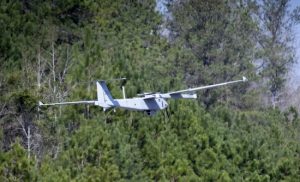Using Viasat’s global L-band space and ground network, it’s an on-demand managed L-band service for communications. It aims to meet, in small form factors, government requirements for highly reliable, high-speed beyond line-of-sight (BLOS) connectivity.
The Enhanced version of LAISR is aimed at meeting increased demand for crewed and uncrewed Intelligence, Surveillance and Reconnaissance (ISR) missions. Viasat highlights they increasingly need consistent SATCOM connectivity to transmit large volumes of data.
Enhanced LAISR is designed to enable users to “access the service whenever and wherever it is needed”, says the company. For example, military operations, particularly, require all-weather resilience and network reliability.
Note that LAISR was originally developed by Inmarsat.
Enhanced LAISR
“Enhanced LAISR is the latest example of Viasat’s continuous focus on enhancing terminals and services to deliver additional value and resilience to our government customers as their needs evolve,” said Chief Technology Officer of Viasat Government, Steve Gizinski.
“With Enhanced LAISR, we are expanding upon the proven LAISR capability and our robust service level agreements to provide a highly flexible and accessible service to support crewed and uncrewed ISR missions worldwide.”
To connect to Enhanced LAISR services, the new Enhanced L-band Maritime Antenna (ELMA, which supports Data rate up to 3 Mbps both directions), and (“soon-to-be available”) LAISR-COTM (comms-on-the-move) terminals will be used.
Additional terminals are in development, says the company, to provide the capabilities via a further reduced SWaP form factor.
All traffic passes through Satellite Access Stations (SAS) and is backhauled via the company’s secure Multiprotocol Label Switching (MPLS) network. It then goes to the customer’s specific destination (ground control stations, operation centers, cloud-based services or remote terminals, worldwide). This is done via private terrestrial line connections, the public Internet or SATCOM.
You can read more about the satellite-based service on the Viasat website.
Blue Force Tracker
Viasat also recently announced a five-year, $153 million dollar contract from the U.S. Defense Information Services Agency.
As a result, it will provide network services for the U.S. Army Project Manager Mission Command (PM MC) Blue Force Tracker (BFT) programme.
![]() This network provides critical situational awareness for the U.S. Army and joint services. Specifically, it will enable the U.S. military and allied forces to share near real-time situational awareness and GPS data on friendly force and enemy. Additionally, it can share operational maps and graphics, and command and control (C2) messages.
This network provides critical situational awareness for the U.S. Army and joint services. Specifically, it will enable the U.S. military and allied forces to share near real-time situational awareness and GPS data on friendly force and enemy. Additionally, it can share operational maps and graphics, and command and control (C2) messages.
Finally, the period-of-performance for the contract includes a base year with four one-year option periods.
“Viasat is honoured to continue its history of providing support for the global L-Band BFT network and systems, and the continued modernisation of how critical situational awareness is made available across the tactical edge at scale,” said David Schmolke, Vice President of Mission Connections and Cybersecurity, Viasat Government.
Viasat completed its acquisition of the UK company Inmarsat in May 2023.
Image: Viasat
See also: Space Norway, Viasat eyes Arctic region broadband coverage

